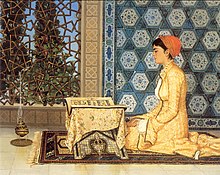
Back المرأة في الإسلام Arabic ইসলামে নারী Bengali/Bangla Dones en l'islam Catalan Зударий исламехь CE ژن لە ئیسلامدا CKB Ženy v islámu Czech Merched ac Islam Welsh Islam og kvinder Danish İslam u cêniye DIQ Virinoj en Islamo Esperanto
This article may be too long to read and navigate comfortably. When this tag was added, its readable prose size was 22,000 words. (May 2023) |
| Part of a series on |
| Islam |
|---|
 |
| Part of a series on |
| Women in society |
|---|
 |

The experiences of Muslim women (Arabic: مسلمات Muslimāt, singular مسلمة Muslimah) vary widely between and within different societies.[2][3] At the same time, their adherence to Islam is a shared factor that affects their lives to a varying degree and gives them a common identity that may serve to bridge the wide cultural, social, and economic differences between them.[2][3][4]
Among the influences which have played an important role in defining the social, legal, spiritual, and cosmological status of women in the course of Islamic history are the sacred scriptures of Islam: the Quran;[5] the ḥadīth, which are traditions relating to the deeds and aphorisms attributed to the Islamic prophet Muhammad and his companions;[6] ijmā', which is a scholarly consensus, expressed or tacit, on a question of law;[7] qiyās, the principle by which the laws of the Quran and the sunnah or prophetic custom are applied to situations not explicitly covered by these two sources of legislation;[8] and fatwā, non-binding published opinions or decisions regarding religious doctrine or points of law.
Additional influences include pre-Islamic cultural traditions; secular laws, which are fully accepted in Islam so long as they do not directly contradict Islamic precepts;[9] religious authorities, including government-controlled agencies such as the Indonesian Ulema Council and Turkey's Diyanet;[10] and spiritual teachers, which are particularly prominent in Islamic mysticism or Sufism. Many of the latter, including the medieval Muslim philosopher Ibn Arabi, have themselves produced texts that have elucidated the metaphysical symbolism of the feminine principle in Islam.[11]
- ^ "Artist Feature: Who Was Osman Hamdi Bey?". How To Talk About Art History. April 27, 2017. Retrieved June 13, 2018.
- ^ a b Siraj, Asifa (October 2011). "Meanings of modesty and the hijab amongst Muslim women in Glasgow, Scotland". Gender, Place & Culture: A Journal of Feminist Geography. 18 (6). Taylor & Francis: 716–731. doi:10.1080/0966369X.2011.617907. ISSN 1360-0524. S2CID 144326780.
- ^ a b Herbert L. Bodman; Nayereh Esfahlani Tohidi, eds. (1998). Women in Muslim Societies: Diversity Within Unity. Lynne Rienner Publishers. pp. 2–3. ISBN 978-1-55587-578-7.
- ^ Ibrahim, I. A.; Abu-Harb, Ibrahim Ali Ibrahim (1997). A Brief Illustrated Guide to Understanding Islam. Darussalam. ISBN 978-9960-34-011-1.
- ^ Bouhdiba, Abdelwahab (2008). "The eternal and Islamic feminine". Sexuality in Islam (1st ed.). London and New York City: Routledge. pp. 19–30. ISBN 9780415439152.
- ^ Glassé, Cyril (1989). The Concise Encyclopaedia of Islam. London, England: Stacey International. pp. 141–143.
- ^ Glassé, Cyril (1989). The Concise Encyclopaedia of Islam. London, England: Stacey International. p. 182.
- ^ Glassé, Cyril (1989). The Concise Encyclopaedia of Islam. London, England: Stacey International. p. 325.
- ^ Nasr, Seyyed Hossein (2004). The Heart of Islam: Enduring Values for Humanity. New York: HarperOne. pp. 121–122. ISBN 978-0-06-073064-2.
- ^ Schleifer, Yigal (April 27, 2005). "In Turkey, Muslim women gain expanded religious authority". The Christian Science Monitor. Retrieved June 10, 2015.
- ^ Murata, Sachiko (1992). The Tao of Islam: A Sourcebook on Gender Relationships in Islamic Thought. Albany: State University of New York Press. pp. 188–202. ISBN 978-0-7914-0914-5.
© MMXXIII Rich X Search. We shall prevail. All rights reserved. Rich X Search